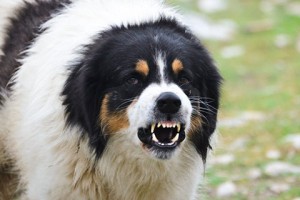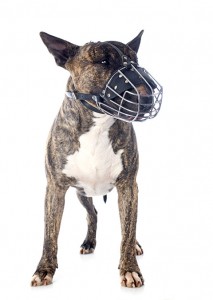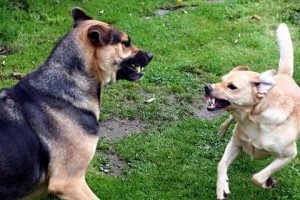
Top Ten Reasons Why Dogs Bite
Posted by admin on April 30, 2014
1. Poor breeding practices. Choosing a good dog from a breeder starts with a thorough investigation of the breeder’s practices. Find out how the breeder chooses which dogs to mate together. He should be selecting breed pairs based on genetics, meaning that the breeder looks for dogs who carry certain genetic traits and mates them with dogs who are most likely to replicate the desired traits or to eliminate problematic traits.
For example, if the breeder is trying to end up with puppies who are a certain color, he or she should be consulting genetic charts to find out how each color is produced. If a black dog can only produce grey or black puppies, and the breeder wants gold-colored puppies, he should not be pairing his prize gold stud with a black bitch.
Conversely, in certain breeds, a white coat is associated with deafness. For that reason, a white dog of these breeds should be spayed or neutered as soon as possible so they never produce more white offspring.
Your breeder should be knowledgeable about the breed standard of the breed(s) with which he is working, and should be able to tell you exactly which traits he is hoping to perpetuate or eliminate with each breeding pair. Check out our sister site to search for breeders in your area.

It’s hard to blame a dog for biting if the dog is being poked with a stick, jumped on, or having its tail pulled time and time again.
2. Provocation. Unfortunately, many people just don’t know how to treat dogs. It’s hard to blame a dog for biting if the dog is being poked with a stick, jumped on, or having its tail pulled time and time again. Certain breeds will deal with cruel treatment better than others, but all dogs have their limits.
If you have children, be sure to supervise them when they play with your dog until you are absolutely sure they know how to treat the dog humanely.
Make sure you don’t leave your dog outside for hours on end with little or no supervision. You never know when Johnny from down the street will stop by and begin poking the dog with a stick. If possible, leave your dog an escape route such as a dog door into your home, a large fenced yard so he can get someplace out of reach, or a dog house where he can retreat.
3. Over exuberance. Even well-behaved dogs can get over-excited, causing them to bite the hands of those they love. Keep in mind that it is very tough for most dogs to see beyond their snouts, so if you are playing a rambunctious game of tug-o-war or if you are giving the dog a treat, it is your responsibility to keep your fingers out of the way.
When you play tug games, choose a toy that is long enough for you to keep your hands at one end, well away from the dog’s mouth. When hand-feeding a dog, place the food flat on your palm so the dog can pick it up without accidentally nipping your fingers.
4. Stranger anxiety. Like people, some dogs love meeting new friends, and other dogs are less excited about strangers. If you know your dog doesn’t warm up to new people very quickly, make sure you have a plan for how you will keep people from being bitten. You might confine the dog to certain areas of your home when you have company or you might have the dog wear a muzzle if there is a possibility you will be running into people he or she doesn’t already know.
When people see your dog and approach with a hand held out, you’ll need to be able to stop them before they get too close. Spend a little time before you get into this situation thinking about how to refuse their requests to pet your dog without being rude or obnoxious. You might want to say something like, “I’m sorry. He’s a little shy about meeting new people. I’d hate for you to get bitten.”
Read Dr. Sophia Lin’s article on stranger anxiety.
5. Illness / injury. Many people have a soft spot in their hearts for dogs, which may include trying to rescue them when they’ve been injured such as following a car wreck. The problem is that dogs often become really cranky when they aren’t feeling well. Injured dogs should be approached with extreme caution. If possible, throw a blanket or towel over the dog’s head before attempting to pick the dog up.
If your own dog is injured or ill, move slowly as you approach, and touch the dog gently on an area of the body that you are sure doesn’t hurt. If you must tend to the injured or sore area, work up to it slowly and gently, talking calmly to your dog as you go. Do your work efficiently and as quickly as possible, and reward your dog with a treat so he comes to associate something positive with the experience. You might want to use a muzzle the first time or two you tend to his wounds until you see how your dog will react.
6. Protection of family & / or property. Many dogs are bred and trained specifically to guard your home and family. If you have one of these dogs, you will need to properly train the dog to attack only on your command. Dogs who have been trained to take maximum advantage of their aggressive tendencies must be managed by responsible, strong pack leaders. If you cannot convince the dog you are the pack leader, you have no business having an aggressive breed. Read Cesar Milan’s article on establishing yourself as the pack leader.
Even dogs who are not, per se, guard dogs often have a desire to protect the home and hearth. Think about this from the dog’s perspective. Every day, the mailman comes onto the front porch, and every day the dog barks. Miracle of miracles! Every day the mailman leaves the porch right after the dog barks. If you were the dog, wouldn’t you think you had the power to make people leave the property? From there, it’s not a big leap to thinking that it is your responsibility to make people leave.
If you live in a climate that allows you to safely take your dog in the car with you on errands, keep in mind that this desire to provide protection may extend to your car as well. If you are leaving the dog alone in the car, make sure he cannot get his mouth outside the window far enough to bite someone, and make sure no one can reach in through the open window.
7. Protection of puppies. One of the most dangerous times to approach a dog is when a new mama is caring for her puppies. Like all mothers, mama dogs can become tigresses when protecting their young. Strangers should be discouraged from approaching the whelping pen until the puppies are at least six weeks old and at least partially weaned.
8. Food aggression. Another dangerous time to approach a dog is at feeding time, particularly if there are other dogs around. Well-trained and socialized dogs may be totally accepting of having someone near them while eating, but other dogs have a big-time attitude about the intrusion. In situations where there are multiple dogs, many dogs feel they must protect their food at all costs from the possibility that the other dog(s) may eat some of it. This is a basic survival mechanism, rooted in the pack mentality.
In the wild, when a prey animal is killed, the pack leader gets to eat his fill first, then the “lesser” animals in the pack are allowed to approach the carcass. Even though dogs have been domesticated for thousands of years, they still require intense training to overcome this basic instinct. If you are working with your own dogs, it’s important that they realize you are the pack leader, and you get to be the one who decides when it’s time for them to eat. If you are near someone else’s dogs when they are eating, you will need to be aware that there are very likely going to be some food aggression issues. Take extra care before you approach any dog who is eating. This is true not only for meals, but also for treats and bones.
9. Fear. This bite motivation is often overlooked. It is assumed that if a dog is going to bite you, it is doing so to prove his dominance. However, many times dogs who are scared to death will bite, simply out of a survival instinct. They may or may not give any warning when they are approaching this breaking point, and if they do give any signs, they may be subtle. Obviously, a dog who is growling or raising his hackles should be watched for aggressive biting, but other signs are not so clear.
A good rule of thumb is to watch the dog’s tail. A tail that is held upright indicates (usually) a happy dog. A tail held between the legs or low to the ground may indicate some degree of fear. Another sign may be how the dog is leaning: a dog leaning forward is generally a good sign, assuming there are no other aggression indicators like bared teeth. However, a dog leaning away from you may indicate a dog who is afraid, and you just don’t know how he is going to react to any movements you make.
Read the PetPlace’s article on fear aggression.
10. Poor training / socialization. The last of the top ten reasons why dogs bite is due to poor training or socialization. This feeds into many of the other problems mentioned above, such as food aggression, stranger anxiety, and over-exuberance. From the moment you take a dog into your home, you are accepting the responsibility of training and socializing that dog to be a responsible member of the community.
At a bare minimum, you should be able to call your dog off if he starts to attack someone. Preferably, your dog should understand that biting is never acceptable. Socialize your dog to as wide a variety of sights, sounds, people, and experiences as possible to prevent fear biting.



